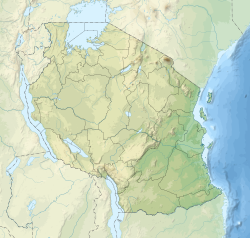Sanje ya Kati
Medieval Swahili settlement in Kilwa District, Lindi Region From Wikipedia, the free encyclopedia
Sanje ya Kati (Swahili Kisiwa cha kale cha Sanje ya Kati) is a protected, uninhabited historic site located on Sanje ya Kati Island in Pande Mikoma ward in Kilwa District, Lindi Region of Tanzania's Indian Ocean coast. The site is home to medieval Swahili ruins that have yet to be fully excavated.[1][2][3][4]
| Location | Tanzania |
|---|---|
| Region | Lindi Region |
| Coordinates | 9°3′14″S 39°32′1″E |
| Type | Medieval Settlement |
| Part of | Swahili Culture |
| History | |
| Builder | Swahili people |
| Material | Coral rag |
| Founded | 10th century AD |
| Abandoned | unknown |
| Cultures | Swahili |
| Site notes | |
| Excavation dates | none |
| Ownership | Tanzanian Government |
| Public access | Yes |
| Official name | Sanje ya Kati National Historic Site |
| Type | Cultural |
Sanje ya Kati hosts significant archaeological ruins, a fortified trading post that includes a significant structure – the Sanje ya Kati mosque.[5]
The mosque
Summarize
Perspective
Constructed sometime in the latter half of the 11th century,[6] the mosque shares design elements with the early Shirazi mosque found on Kilwa Kisiwani.[7] Built with precisely cut coral blocks, the mosque measures approximately 10.21 by 9.46 meters (33.5 by 31.0 ft).
The prayer hall features symmetrical entrances on opposite walls and evidence of past structural support through four wooden columns. The foundation rests on a platform of sand, suggesting an earlier phase of construction possibly dating back to the beginning of the 11th century. The current mosque structure itself is believed to have been built later in the century.
The mihrab, a niche indicating the direction of prayer, differs from typical Swahili mosque designs. Unlike protruding structures, this mihrab is seamlessly integrated into the wall. This unique feature has led some researchers to propose a possible association with the Ibadi Muslim community.[8][9]
Flanking the rectangular prayer hall, which measures approximately 10 by 9 meters (33 by 30 ft), are two wings. The east wing housed the main entrance, while the south wing featured a platform and a courtyard with a well. Notably, the well predates the current mosque structure.
Excavations have revealed evidence of an even earlier mosque at the site. Reused blocks with high-quality stucco decoration suggest a potentially grander structure built in the mid-11th century.
See also
References
Wikiwand - on
Seamless Wikipedia browsing. On steroids.
